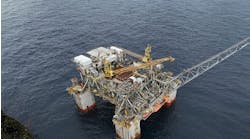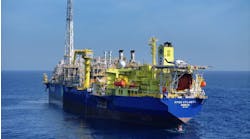Andrew Bartlett - Technical Contributor
Hydraulic systems are common to operate remote valves on FPSOs. These systems operate at higher pressures than comparable pneumatic systems, typically in the range of 1,500 psig to 3,000 psig. This higher pressure in conjunction with a non-compressible fluid is able to handle a wide range of valve sizes and types, while minimizing the physical size of the valve actuators required.
The risk of major problems with marine hydraulic systems can be minimized by paying attention through each stage of implementation. Key points include gaining a good understanding of the application, and working closely with the design team and equipment suppliers to produce a workable package. It is critical to establish and maintain good communications with the construction, commissioning, and operations teams, and to follow closely the activities through these three latter phases.
Design
The hydraulic piping/tubing run lengths will vary in length depending upon the position of the valves relative to the hydraulic power pack(s). A typical FPSO with a single aft power pack has total run lengths from 25 m to 350 m (82 ft to 1,148 ft). Piping headers should be used along the length of the vessel for the supply and return lines. These headers can feed the solenoid control racks to ensure an adequate flow without a substantial pressure loss. Hydraulic headers should be sized for simultaneous operation of a typical set of valves. Individual tubes from the solenoid control racks should be sized in accordance with each valve actuator swept volume.
System sizing generally should aim to provide fast valve operation response time. Some valves, however, require slow opening or closing times to avoid hydraulic hammer. Individual adjustable restrictors can be installed in the hydraulic tubing close to the solenoid panels in these cases. Thus, the response time of these valve actuators can be adjusted without performance loss elsewhere in the system.
Both the hydraulic fluid characteristics and the external environment need to be considered when selecting tube sizes and materials. Type 316L stainless steel should be adequate for both mineral oil and water-glycol based fluids. It also should be suitable for most marine environments (but see also the section below on installation). A nickel-copper alloy (such as Monel) should be used for tubing and fittings in ballast tanks where the lines will be immersed in aerated sea water.
Valve actuator and pump internals should be stainless steel. A stainless steel liner or chrome plating should be used where full stainless steel cannot because of component form or the required mechanical properties. This is particularly important for water-glycol based fluids. Note that corrosion resistant materials should be used for all wetted parts of the valve actuators, including the cylinder (or cylinder liner), the piston head, and the piston spindle.
Hydraulic pumps must be fully compatible with the fluid type. Mineral oils provide a good degree of lubricity for the pump internal parts in the hydraulic circuit, but generally exhibit greater viscosities than water-glycol fluids, particularly at low ambient temperatures. Pumps on water-glycol service may suffer from small amounts of cross-contamination between the pump lubrication oil circuit and the hydraulic fluid circuit. A wise precaution is to select a pump lubricating oil that is compatible with the selected water-glycol fluid.
A physical support system should avoid direct contact between stainless steel tubing and the carbon steel of the vessel. One method is bolted plastic tube clamps. The clamps are available generally for multiple runs, if required. Stainless steel tray or stainless steel/glass fiber ladder rack also can be used where more physical tubing protection is required. Trays should be perforated to prevent the build-up of water from sea spray around the tubing to minimize potential corrosion.
Bulkhead penetration designs that involve welding the hydraulic tubing direct to carbon steel should be avoided. This is to avoid creating points on the tubing where corrosion can begin to form in the saline atmosphere. Stainless steel penetrating plates can be made on site and the hydraulic tubing welded to it. Alternately, stainless steel pipe collars can be welded into the carbon steel wall. The tubing can then be welded to the stainless steel collars.
System sizing should target fast response time for valve operations except for any valves that need to avoid hydraulic hammer. Individual adjustable restrictors installed in the hydraulic tubing close to the solenoid panels can be used in these cases. In this way, the response time of these valve actuators can be adjusted without sacrificing performance elsewhere in the system.
Tube wall thicknesses should be standardized for each tube size. The vessel likely uses stainless steel tubing on other services, for example process impulse lines and instrument air supplies. Using one wall thickness for each tube diameter, and rated for the highest pressure service, should help prevent inadvertent application of tubing above its rating.
Installation
Stainless steel and nickel-copper tubing should be stored in a clean and dry environment. The tubing should be stored apart from other materials, and should be covered to prevent build up of metal fines from construction activity. Care needs to be exercised handling tubing to avoid scratches and dents where pitting corrosion could form. This is particularly relevant for stainless steel.
Tube benders should be used to prevent wall deformation. Burr removal tools also should be used to minimize introduction of metal particles into the hydraulic circuit. The open ends of installed tubing lengths should be sealed with plastic caps for the same reason.
It may well be that tube fittings from more than one supplier are used. If so, it is therefore important to conduct a site test with all the proposed manufacturers´ tube fittings prior to starting the main body of installation. This ensures that adequate joints can be made with the proposed combinations. One item to confirm is that all dual-ferrule fittings can be used with each tube size and wall thickness. Particular attention should be paid to the ferrules correctly crimping the tube and forming the required seal at the test pressure. Another item to confirm is that socket weld fittings correctly match the tube outside diameter, and that sufficient wall thickness exists at all tube sizes for welding.
Stainless steel tubing should be coated with a protective layer immediately after installation and testing. This layer need only be a thin transparent lacquer, and can be applied either by brush or localized spraying. The purpose of this coating is to help prevent surface pitting from deposits of particulate matter from cold cutting and grinding operations. Alternately or in addition to the above measures, 317L or 904L stainless steel tubing can be substituted for type 316L. Those two types offer a higher molybdenum content and consequently a greater resistance to pitting corrosion. This is more important for tubing than for fittings. The latter have thicker metal parts so type 316 stainless steel should be adequate.
Tubing runs should be installed from the solenoid panels to the individual valve actuators in such a way as to avoid creating air pockets. This is because it is not feasible to install vent points along the route of each tube. Ideally, the tubing from each valve actuator should run upwards in continuous steps back to the solenoid panels. The air from each line can then be vented at the panel.
Valve position indicators
Particular care needs to be taken in applying flow-based Valve Position Indicating Transmitters (VPITs) to submersed valve service. These instruments measure the flow of fluid through the actuators during the opening and closing cycles, and give an inferred measurement of valve position. VPITs can be mounted in accessible areas outside of tanks. The instruments typically use a gear wheel type of flow movement, but other movement types can also be used.
Position indicator points to verify include the following:
- Fluid compatibility – Water-glycol based fluids can corrode ferrous or copper-based alloys. Low viscosity fluids can lead to component wear in some VPIT types due to inadequate lubricity. Some VPITs have difficulty registering low flows of water-glycol based fluids because the fluid passes around the gears.
- Volume calibration for opening and closing cycles – The VPIT may need to be calibrated to accept different volume flows on the opening and closing cycles. Some single-cylinder double-acting valve actuators have different swept volumes on opening and closing due to the presence of the piston spindle.
- Valve actuator volume ranges – Actuator volumes may vary from a fraction of a liter to 15 or more liters. So, it is necessary to ensure that the selected VPIT can cover a wide range of flows.
- Resistance to hydraulic impulses – The VPIT resistance to hydraulic impulses needs to be verified. Operation of a valve in one line can lead to transient pulses in other lines. VPIT instruments with moving parts of a lighter construction may register false rotations under these circumstances.
- Bench test verification – A bench test with a large number of opening and closing cycles should be carried out with the proposed VPITs and various simulated actuator volumes. Test failures can be investigated and remediated prior to installation on the vessel.
- Alternative instrumented solutions – Technology constantly advances. Alternative valve position detection methods such as direct mounted sealed electronic transmitters should be considered.
- Alternative plant design – Consideration should be given to the piping and equipment design so all valves are outside of tanks.
Commissioning
Headers, individual tube runs, and valve actuators need to be thoroughly cleaned and flushed prior to the introduction of hydraulic fluid. Residual amounts of water-glycol fluids should not be left in the system for long periods. The vapor from these fluids can be more corrosive than when the system is completely filled.
A controlled scheme of operation and maintenance that involves regular cleaning of the hydraulic fluid needs to be introduced. The scheme should include the following steps:
- Regular recycling of the fluid through the filters in the hydraulic power pack
- Regular replacement of filters in the hydraulic power pack
- Regular replacement of filters in the solenoid panels
- Regular examination of the fluid cleanliness at the hydraulic power pack.
Clean fluid is essential to the correct operation of the system. Small particles in the fluid can block restriction orifices, flow meter gears, and solenoid valve ports. Some residual solids are left in the system after installation, even with flushing. Regular fluid recycling and filter replacement gradually should clear particulate matter. The frequency of filter changes can be reduced over time, as the required level of cleanliness is approached.
The hydraulic fluid cleanliness requirements may vary from system to system. Three standards of fluid cleanliness are the International Standards Organization (ISO) 4406, the Society of Automotive Engineers (SAE) AS 4059, and the National Aerospace Standard (NAS) 1638. These standards express fluid cleanliness in terms of the number of particles of specific sizes allowable, per unit volume.





